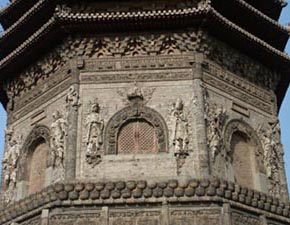
The pagoda at Cishou Temple at Balizhuang (Eight Li Village) in Beijing's western suburbs was originally named Yong'anwanshou Pagoda (Pagoda of Lasting Peace and Longevity). Later it was called Cishou Pagoda (Pagoda of Benevolence and Longevity) after the temple it was in.
Cishou Temple was built in 1576 during the Ming Dynasty by decree of Empress Dowager Li, mother of Emperor Zhuyi. It was allegedly an imitation of the pagoda at Tianning Temple outside Guang'anmen, but it was built on a larger scale. The temple buildings were destroyed during the Qing Dynasty, but the pagoda remains.
It is octagonal, solid, over fifty meters tall with thirteen tiers of eaves. The brick base is in the form of a Sumeru pedestal and is decorated with relief sculptures of Buddha, flying apsarases, vajra guardians, archways, lotus petals and the Eight Treasures. The most impressive ornamental sculptures on the upper part of the Sumeru pedestal are the musical instruments, including sheng, xiao, qin, se, yunban, gongs, drums and flutes. The refined carving depicts the rich variety of musical instruments of the Ming Dynasty and is very valuable.
The first storey of the pagoda is majestic, typical of the multi-eaved style of the Liao and Kin dynasties. A false arch decorates the four sides facing the four directions; the other four sides have false windows. Carved on the headpiece of the arches are cloud and dragon patterns. Sculptures of vajra guardians, made of clay over wooden frames, flank the arches. The windows are decorated with little statues of seated Buddha and cloud patterns. Relief sculptures of bodhisattvas flank the windows. Eight brick columns decorated with dragon patterns stand at the corners of the pagoda. The name of the pagoda -- Yong'anwanshoo Pagoda -- is inscribed on the stone headpiece of the southern arch. Thirteen levels of eaves rise above the first storey. The steeple is supported by a pedestal with ornamental lotus petals and surmounted by a precious bead, resembling Tianning Temple Pagoda.
Transportation: Bus 335, 336 are accessible and get off at Balizhuang stop.
Admission: Free.
(China.org.cn)
|

